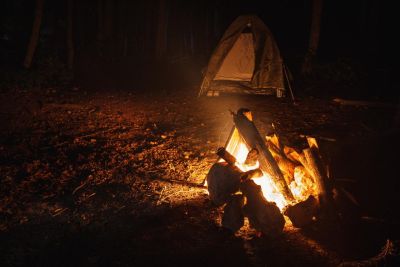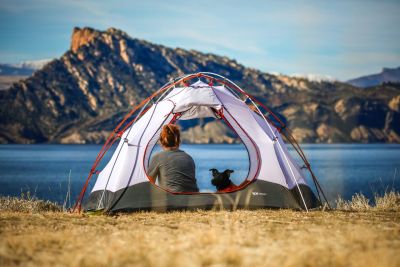
Tips on How to Choose a Sleeping Pad for Camping
In several ways, a sleeping pad is just as important as your sleeping bag, yet, very few campers are aware of this. In many cases, campers will choose a pricey sleeping bag, and then buy the cheapest sleeping pad they can find. After spending a few cold and uncomfortable nights out in the wild, they usually blame the sleeping bag, without realizing that it is the sleeping pad that is causing the main problem.
Here is a guide that you can use to help you choose the right sleeping pad for your next camping trip.
The Purposes of a Sleeping Pad
The main purpose of sleeping pads is to provide insulation to the camper from the hard and cold ground. The second objective of a sleeping pad is to give the camper a more comfortable surface to sleep on.
If you are planning to go camping in winter, look for the sleeping pads that have an R-Value of 5 or more. For car camping in the summer, you can get a great night's rest with a good quality sleeping pad.
When comparing the foam pads to the air-filled pads, the air-filled versions are warmer and more comfortable. These pads are also less bulky when compared to the self-inflating pads.
Where to Buy a Sleeping Pad
When shopping around for a sleeping pad, look for quality and reliable online retailers like Moosejaw, Eastern Mountain Sports, Campsaver, and REI. REI is one of the best online retailers as they offer a well-organized website, along with technical information on each of the sleeping pads that they sell.
The Benefits of a Sleeping Pad
There are 2 main advantages that sleeping pads provide:
Comfort
Comfort is the main aim of a sleeping pad. These products provide cushion and protection from the ground. In some cases, a sleeping pad could become a substitute for a standard mattress. While it may seem tempting or a good idea to "avoid creature comforts" when you go camping, there is also no reason why you should be torturing yourself by trying to sleep on a hard and uncomfortable surface.
Warmth
The warmth that sleeping pads are designed to provide a camper with should be one of the top priorities when you start shopping around for a sleeping pad. A sleeping pad is essential when it comes to keeping you warm. Regardless of how fancy or thick your sleeping bag might be, when you are sleeping, the bottom part of your sleeping bag will lose its insulating abilities since your weight will crush the insulation. When this insulation is squashed, and you haven't used a sleeping pad, you will be exposed to the cold and hard ground.
Sleeping pads are designed to prevent these problems. Sleeping pads offer an effective insulating barrier that is formed between you and the cold and hard ground. The thickness of the pad ultimately determines how much insulation this barrier will provide.
Types of Sleeping Pads
Sleeping pads come in 3 main types for camping. These include:
- Air Pads
- Self Inflating Sleeping Pads
- Foam Sleeping Pads
Each of these sleeping pad types is designed for specific uses.
1. Foam Sleeping Pads
One of the main advantages of foam sleeping pads is that they cannot leak. In previous years, the foam sleeping pad used to be the most popular choice. However, today, very few campers use these sleeping pads, other than the backpackers that pack ultralight.
The main reason why the foam sleeping pad is no longer as popular as it once was includes the lack of comfort and warmth, particularly with the thinner pads, along with a much lower weight-to-warmth ratio when you compare them to the high-quality air-pads. Besides, the foam sleeping pads are also rather bulky, which comes as a surprise given the low levels of insulation that they provide.
While the foam sleeping pads still deserve their place when it comes to campgrounds and inside backpacks, the air-sleeping pads are for many campers, a far better choice.
2. Self-Inflating Sleeping Pads
A few years back, the self-inflating sleeping pad was the most popular choice. This was partly because these sleeping pads were lightweight and highly durable. These sleeping pads are still a popular choice for many campers.
The self-inflating sleeping pad comes in varying insulating values, widths, and thicknesses. In most cases, the thicker pads offer more comfort and warmth. However, more adhesive pads are also relatively heavy and bulky.
As the name of the product suggests, the self-inflating sleeping pads do partially self-inflate. However, these sleeping pads are not able to inflate fully by themselves. In most cases, anything from 5 to 15 breaths of air is needed to inflate one of these sleeping pads.
At the same time, trying to deflate one of these sleeping pads is not an easy task. When you open the valve, it will let out around 50% of the air that is contained inside the mattress. To get the rest of the air out, you will need to roll out the pad slowly using your knees to stop air from getting back inside the pad.
When it comes to backpackers, the self-inflating sleeping pads do not make a lot of sense, since they are heavy and bulky. They also do not provide the same level of warmth, like the ultra-light and newer air-filled pads can. However, for base camping or car camping, the self-inflating pad is still one of the popular choices.
3. Air-Pads
The newest version of sleeping pads includes the air pads. Unlike the self-inflating sleeping pad, the air pads are not self-inflating. When considering "warmth to weight", the air pads offer the highest value. For example, a four-season ultra-light pad (with an R-Value above 5), will usually weigh under 2 pounds, and they pack down really small.
The air pads are incredibly lightweight and very packable; these sleeping pads have quickly become the top choice for most backpackers.
Yet the air pads are not just for hikers and backpackers. For car camping and float camping, the air pads happen to be a highly favorable choice. Their warmth, thickness, and ease of either deflation or inflation and their sheer comfort are what make the air pad the perfect all-around sleeping pad.
Overall, unless you have decided on a particular reason why you need to buy another type, most campers find that the air pad is the best type of sleeping pad. This is particularly true for campers and backpackers that are looking for a comfortable and warm pad that packs down small and weighs next to nothing.
Foam Sleeping Pad vs. Air Sleeping Pad
There is no wrong or right choice when it comes to choosing an air-filled or foam sleeping pad. Each of these types come with their drawbacks and benefits. However, there are still a few guidelines that campers should be aware of before deciding on what type of sleeping pad to invest in.
When it comes to warmth, the air-filled pads are superior when compared to the foam pads. Many of the foam pads have an R-Value that is lower than 1.3. which is ok for camping in warm weather, but offer very little if the weather goes below freezing.
Which Sleeping Pad Should You Choose
The sleeping pad that you decide on should match up to the camping type that you participate in. Here are a few guidelines to follow:
Winter Camping
Look at the air pads or self-inflating pads that have an R-Value of 5 or more. The lightweight foam pads can also be used under an air pad, which will help to increase its R-Value. An example of a great air pad that you can use for camping in the winter includes the Thermarest NeoAir Xtherm with an R-Value of 5.7.
Warm Weather Backpacking
When each ounce that you are carrying starts to count, you have 2 options. You can go with one of the ultra-light foam pads. Yet keep in mind that they have a very low R-value of 2 or less. The next options would be an ultra-portable and ultra-light air pad. The popular brands of air pads made for float camping and backpacking, include Thermarest and Big Agnes.
Car Camping
For car camping, go with the softest, warmest, and thickest air pad or self-inflating sleeping pad available.
Sleeping Pad for Occasional Backpacking or Car Camping
If you are not one of those hard-core backpackers, yet you need a sleeping pad that works "ok" with backpacking, then a rectangular-shaped air pad that has an R-Value of 4 or more will work well. The sleeping pads with a higher R-Value will mean that the surface is thicker and softer to sleep on. Also, look at the sleeping pads that have a 25-inch width rather than the standard 20-inch width. Make sure you do a bit of research on the different brands and prices before you decide on the best sleeping pad to match up to your needs.





